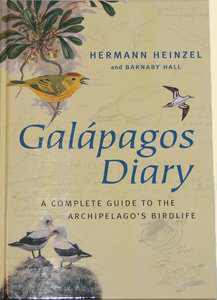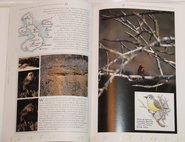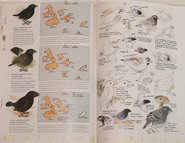Reviewed by Grant McCreary on July 6th, 2007.
What birder wouldn’t want to go to the Galapagos Islands? The
archipelago’s total number of species is pretty low, but the
relative high number of endemics and the tameness of the animals
more than make up for it. But the trip is fairly expensive, and
it is a long ways away for most of us. While we save up for the
trip there are a couple of other options for experiencing the
islands. The BBC has produced a fantastic series on the islands
that is available on DVD and Blu-ray
.
And of course there are books. Galapagos: A Natural History
by
John Kricher is an excellent introduction to the islands. But
if you would like to experience the birds of the islands,
then you need to read Galapagos Diary
.
The first part of this work’s title is very apt. It is truly the diary of a trip that the authors made to the islands. Unfortunately, the second part of the title is not correct. It is not quite a complete guide to the birds of these enchanted islands.
The first half of the book recounts the authors’ trip. This section is essentially a trip report. That may sound pretty boring, but they make it work. It is very well written, entertaining, and informative. On this trip they spent a couple of weeks there in the mid 90’s. This was at least the second trip for both of them (Heinzel provides the text and drawings, while Hall was the photographer). Heinzel is very familiar with the islands and the birds and makes a good tour guide for the reader. The account would benefit anyone preparing for their own trip, but is also good reading for those who are not.
This section is liberally illustrated with Heinzel’s drawings and Hall’s photographs. The drawings are wonderful and charming. They seem to capture well the birds’ characteristics and personality (at least for those species I’m familiar with). The photographs range in quality from excellent to “I can’t believe they published this”. The problem shots are usually out of focus. From the text, it seems the photographic equipment wasn’t up to task for certain situations. But the vast majority of the pictures were at least adequate. And while I certainly would have liked to see some better quality photos here, I found that they really didn’t bother me too much. They contributed to the impression that this was a personal trip report and not some glossy travel brochure.
The second part of the book is species accounts of most of the regular Galapagos birds, including all of the endemics. Some basic information is given in text, and includes both notes on life history and identification. Maps are included for most species. They will always show where the authors saw the bird on their trip, and some include an overall range as well. The main feature here is the copious amounts of drawings. There is at least one main, finished illustration for each species. Additionally, there are many secondary illustrations. Some are completely finished and colored, but some are not. These are meant to illustrate some special quality about the bird – either behaviorally or physically. These are also annotated with many notes pointing out the features the illustrator was trying to convey.
The 13 species of Darwin’s finches are given more extensive treatment. This is not surprising due to the family’s fame and the fact that they pose the most difficult identification problem on the islands. The first two pages are an overview of the species, and then each one is covered in greater detail. Each one has its own map along with many drawings. Finally, there are several pages of photographs. Overall, 23 pages are dedicated to these birds.
This section would be helpful for identification, but it does
not take the place of an actual field guide. I believe the best
field guide for the islands is Birds, Mammals, and Reptiles of the Galapagos
Islands. It
includes all the birds included in Galapagos Diary plus others that are
vagrants to the islands. Overall, the field guide is better
for identification purposes. However, the diary nicely
supplements it in places. For instance, Heinzel illustrates
an immature Red-billed Tropicbird and boobies in flight,
which are not shown in this field guide.
Finally, there is a graph showing the distribution of birds across all the islands. This is incredibly helpful for both trip planning and identification. For instance, if you see a Ground-finch on Genovesa island you know that it is either a Large or Sharp-billed. The other two Ground-finches don’t occur on that particular island. However, the field guide also includes such a chart and it is more extensive.
The taxonomy used here is a little behind the times. The subspecies of Audubon’s Shearwater encountered here is now considered a full species – Galapagos Shearwater. Also, the Masked Booby complex has since been split, and those on the Galapagos are currently considered the Nazca Booby. Also, readers from North America should note that European bird names are used when there is a difference. For instance, the bird we know of as the Black-bellied Plover is instead called the Grey Plover.
The most annoying thing about this book is the hard-to-read font used in some places to annotate drawings and give additional information. It is in some sort of handwritten script. I’m not sure if it’s the author’s handwriting, or something else. But regardless, I had great difficulty reading a good bit of it. I appreciate the diary-like feel that this adds to the book, but effective communication is even more important.
Even though this volume does not live up to its title of being the complete guide to the birds of the Galapagos (a true field guide is still needed), it is still recommended. It is almost essential to anyone fortunate enough to travel to these islands. And for the rest of us it is a fascinating read and a great introduction to the unique creatures found there and nowhere else on our planet.
Disclosure: I get a small commission for purchases made through links in this post.







I want to go there